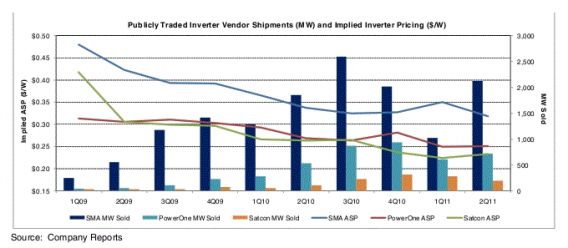One of the worst kept secrets in solar has been SMA's intention to eventually launch a microinverter.
Jeff Osborne of Stifel Nicolaus revealed that SMA will be unveiling its microinverter at Solar Power International in Dallas next month, but the product will not be on sale until 2012 and is not designed for more than a 2-kilowatt system.
According to Osborne, "Management would not disclose rated efficiency or peak wattage. Management aims to focus the product in the U.S., Japan and Australia according to their comments," adding, "When we pressed the CEO/CFO Urbon about size, he indicated that it was not cost-effective above 2 kilowatts despite the potential benefits of shading."
SMA, by far the market share leader in the $6.9 billion photovoltaic inverter market, acquired microinverter IP from OKE Services in 2009.
Jurgen Krehnke, President and General Manager of SMA America clarified the issue and told Greentech Media, “The SMA microinverter can easily scale above 2 kilowatts. However, we believe microinverters are not cost effective above this limit. Microinverters are excellent for difficult roof orientations, starter systems, and small applications but once you get above 2 kilowatts, microinverters are not cost-competitive with leading string inverters and the performance gains, as shown by independent testing, don’t warrant the extra expenditure required for large systems." Krehnke adds, "We are very excited about the future launch of the product. It will feature multiple features that are new to the microinverter market and it will offer significant advantages for installers. We don’t see the microinverter as is a one-size-fits all solution, which is why others perceive a lack of enthusiasm. For SMA, it expands our extensive product portfolio, which provides integrators with the ability to optimize every project, from small residential to utility-scale."
MJ Shiao, GTM Research's inverter analyst and expert, said, "SMA's almost dismissive attitude towards its microinverter product reflects the general consensus on the part of most major centralized inverter manufacturers about the limited application of microinverters. However, SMA's and Power-One's entrance into the space lends credibility to distributed optimization technology and ironically, could be a major boon for market leaders like Enphase and SolarEdge."SMA's decision to distribute in Japan, Australia and the U.S. makes sense; the European markets have been slow to warm to microinverters. Nevertheless, despite SMA's strength in North American distribution, it will be difficult to continue fending off Enphase's rapid success in the U.S., where it has risen to nearly 20 percent residential market share in just a few years."
Power-One (Nasdaq:PWER), the world's second largest central PV inverter firm, announced the launch of their new 300-watt microinverter, marking the first entry in the distributed electronics space of an established central inverter player, a few months ago.
Here's a chart from Osborne which shows inverter prices dropping, although not as precipitously as solar module pricing. Microinverters, despite their potential benefits, still have to compete with central inverter pricing.

We've covered the potential benefits of distributed electronics at length in our solar coverage at Greentech Media. There are potential energy harvest gains, potential improvements in design flexibility, and potential reliability gains. However, there is some question as to whether the microinverter solution or the DC-to-DC power optimizer architecture is the way to go.
Power-One claims efficiency ratings of up to 95.5 percent and a microinverter that is electrolyte-free. That would mean that Power-One is avoiding the use of electrolytic capacitors, which can come with reliability risks if designed by engineers who don't know how to design with electrolytic capacitors. Enphase, the leading microinverter firm, uses electrolytic capacitors and has shipped about a million units.
Other microinverter firms like SolarBridge use film caps in their designs. SolarBridge is focused on the AC module (ACM) segment, has announced a partnership with AU Optronics, and has some other announcements up its sleeve. Expect more news from them at SPI next month.
SolarBridge’s view is that “there are no 'safe' design practices for the use of electrolytic capacitors in long-life, harsh outdoor environments. E-Caps are inherently at risk due to their use of a complex liquid chemical electrolyte that is vulnerable to degradation under long-term exposure to the high temperatures seen in rooftop solar applications.”
Enecsys, claiming in a recent press release to be "the leader in reliable, long-life solar micro inverter systems for residential and commercial applications," has won $41 million in round B VC funding from Climate Change Capital Private Equity, Wellington Partners, NES Partners, and Good Energies.
Microinverter manufacturers include those mentioned above, as well as Direct Grid, GreenRay, and Petra Solar. DC-to-DC optimizer firms include Solar Edge and Tigo Energy. EIQ markets a parallel DC solution. Tigo recently closed a $10 million venture funding round and SolarEdge announced a partnership with Flextronics to manufacture in Ontario to qualify for the Ontario FIT's local content requirements.
Array Converter, the inverterless solar solution, doesn't really fit into either of those categories.



